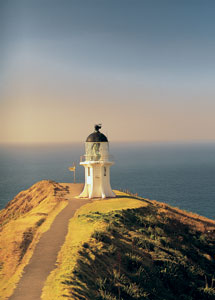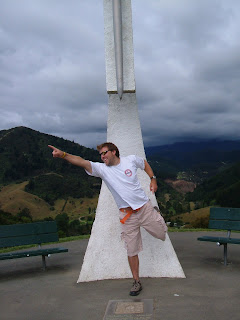So off to the Coromandel it was. The Coromandel is the peninsula of land that forms the western flank of the Bay of Plenty. On a clear day it can be seen from Auckland. At a guess its probably only a couple of hours drive out of town. First stop was Thames. The Coromandel is famous for its gold mining and Thames is basically a mining town. Well, was a mining town, built on the back of the mining in the area. So what do you do in a mining town? Go and visit a mine of course!!! It was only a brief tour mind, and the mine was no longer active. It did however confirm my suspicions - mining for gold is a rubbish job. I am too tall for one, and the gold at this location was pretty rubbish. The processing also resulted in about 50% loss of gold. Not a really impressive return. But being a geologist it was a genuinely interesting tour - and the old boy giving the demos certainly knew his stuff.
We decided to push on north whilst the light was good. Sadly we arrived in Coromandel City at closing time so it was just a quick walk round this frontier style town and then back on the road to find a camp. We decided against heading up the tip of the Coromandel (fantail bay) this time due to the time constraints. Instead we cut across to Waikawau and a DOC site for the night.
Wednesday 4th saw us head south along the eastern side of the Coromandel. First stop was Cathedral Cove. Cathedral Cove has striking white sandy beaches and vertical white cliff lines doted with blooming Pohutakawa trees. Very impressive. The beach is bisected by a headland which has had an arch eroded through it connecting the two beaches of Cathedral Cove together. Now I could go into the formation process of such a feature, but don't want to bore you good folk, so all that needs to be said really is that it is pretty impressive.
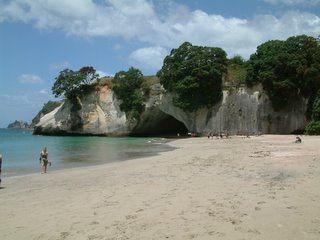 Cathedral Cove
Cathedral Cove
About 10km south of Cathedral Cove is Hot Water Beach. There is pretty much naff all at Hot Water Beach besides the beach and a cafe. However the beach itself is a little different from most other beaches. In the centre of the beach rocks protrude from the headland out into the sea. This is marks the location of the hotsprings. Basically what you do is, with a spade, which you can hire from the cafe, you dig a hole in the sand and let it fill with hot water from the springs. Then you can bathe and wallow to your hearts content, and have the occasional refreshing dip in the cold sea. Sounds great. The reality is that even way before low tide (optimal digging time) crowds start gathering around the rocks, shovels cocked, marking out their terratory, not unlike ze germanz and their sunbeds. So rocking up a couple of minutes before low tide was not the best approach to digging my own natural hot pool. Ah well. After several minutes of futile excavating, it seemed the best tack was to hijack someone elses hole. However with several hundred people all trying the same thing, and with best spots taken, and being closely guarded against invasion it was a pretty unsuccessful adventure. When water was struck however it was indeed mighty hot. Scolding in fact, so be warned. Here is my tip - if you head to Hot Water Beach check the tides and go early, and out of season and stake your claim to a spot very close to the rocks. And if you can get your hands on one - a JCB would do wonders in digging a hole, with the added bonus of flattening invaders at the same time!!!

Oh for a JCB
We headed south to Wentworth Valley and a DOC site for the night before breakfast in Tauranga at a lovely cafe bar, and then it was off to the 'Vegas!!!
The first stop in Vegas was the Whakarewarewa thermal village. This is a living Maori village set in amongst the thermal pools of the area. We took a guided tour around the village by one of the residents. It was brilliant and very insightful. Highly recommended. It is a living village inhabited by Maori. They go about their normal daily routines whilst you wonder around. Kids run free in the streets and dive for pennies off the bridge. Everything in the village is geothermal related. The houses are heated geothermally, food is cooked in central Hangi steam boxes and the baths are geothermal. A wonderful experience.
Then it was off to the Rotorua Museum. This is set in the old bath house on the shores of the lake. A magnificent structure. Several exhibitions are within, including a Kiwi display. This covered everything Kiwi from the bird to the boot polish. Perhaps the most interesting (to me anyway) was the exhibit telling the story of the devastating Tarawera eruption in 1886. To put a scale on it, the eruption was significantly larger than the 1985 Mt St Helens eruption and the mid nineties eruption of Mt Pinatubo in the Phillipines. It killed quite a few folk in the surrounding area, and also destroyed the pink and white terraces. These were considered as one of the seven natural wonders of the world. A real shame. It is also said that the eruption was foreshadowed several days earlier by the sightings of a 'ghost' waka (maori war canoe) paddling furiously away from Mt Tarawera across the lake. A lesson there for all volcanologists i think. Sod the modern gizmos and multi million dollar research - just call ghostbusters!
A quick blast down SH38 took us to the campground at the base of Mt Tarawera. It was here that we had the only rain of the trip. When it rains it pours mind - it properly hooned it down. But thankfully it was short and sweet, and nothing a good bottle of vino and curry cooked up in the back of the surf wagon couldn't fix.
It was an early start the next day as we headed to Wai-O-Tapu, a geothermal park just off SH5,  south of the 'Vegas. Wai-O-Tapu are hte proud 'operators' of the Lady Knox Geyser. I say operators as the geyser is ignominiously induced to perform daily at 10.30am by pouring soap down the spout. Its a whole surface tension thing apparently, with the soap allowing the superheated water and steam to beak throught he cold water barrier holding it below the surface. The initial foaming and frothing is rather entertaining (for about 30 seconds before it gets a bit boring) and is followed by jet of steam and water that can reach up to 10 in the air accompanied by 'ooohs' and 'ahhhs' from the assembled crowd (mainly Japs) gazing in wonderment from the terraced amphitheatre surrounding the geyser. It erpupts for about an hour after initiation. But after a couple of minutes and a few photos there isnlt much else to see really so it was back to the main centre to look around geothermal pools and formations such as the Devils Ink Pots and the Champagne Pool. The water from the Champagne Pool froth over and flow over The Terraces depositing minerals on the way. Come back in a thousand years time and i am assured The Terrace will rival that of the Pink and White Terraces. Hmmmmm. Now wheres my Delorean...
south of the 'Vegas. Wai-O-Tapu are hte proud 'operators' of the Lady Knox Geyser. I say operators as the geyser is ignominiously induced to perform daily at 10.30am by pouring soap down the spout. Its a whole surface tension thing apparently, with the soap allowing the superheated water and steam to beak throught he cold water barrier holding it below the surface. The initial foaming and frothing is rather entertaining (for about 30 seconds before it gets a bit boring) and is followed by jet of steam and water that can reach up to 10 in the air accompanied by 'ooohs' and 'ahhhs' from the assembled crowd (mainly Japs) gazing in wonderment from the terraced amphitheatre surrounding the geyser. It erpupts for about an hour after initiation. But after a couple of minutes and a few photos there isnlt much else to see really so it was back to the main centre to look around geothermal pools and formations such as the Devils Ink Pots and the Champagne Pool. The water from the Champagne Pool froth over and flow over The Terraces depositing minerals on the way. Come back in a thousand years time and i am assured The Terrace will rival that of the Pink and White Terraces. Hmmmmm. Now wheres my Delorean... 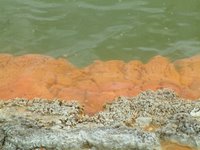
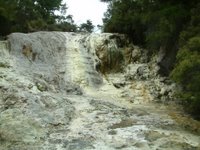

From here we had a quick dip in 'Secret Spot'. This is a hot stream flowing into a cold river, so basically you swim around until you find a spot where the temperature is to your liking. The higher up the stream you go the hotter it is. A fantastic little spot, and i would love to tell you where it is, but as the name suggests...haha. Not really, the irony being that pretty much everyone knows where it is, about half a click off SH5 on the road to Wai-O-Tapu itself. Park by the wooden bridge and head 25m into the bush and there you have it. The best time to go is at night, with candles adorning the river banks, a few bottles of beer and an amazing view through a gap in the canopy to the stars above. Superb.
After chilling out at Secret Spot, and leaving just as a bus load of backpackers turned up (perfect timing) we headed back to the 'Vegas for lunch and then onto the Skyline Skyrides site for a spot of luging. Superb!!!
The trip was coming to a close so we decided to head back home on the Friday evening to beat the traffic and to have a day in Auckland sorting stuff out before Jennas departure back to the UK.


 Sunset at Spirits Bay - nice hat!!!
Sunset at Spirits Bay - nice hat!!!